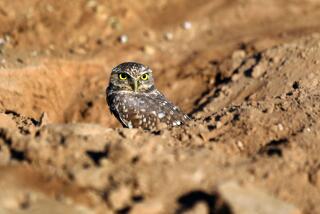On the Wing Again
- Share via
Aerial traffic is intense these days as millions of shore birds and waterfowl complete their winter migration to California under the anxious eyes of biologists trying to calculate the effect of the year’s drought.
A further decline in waterfowl is anticipated, with the population, 6 million just a few years ago, dwindling to 3 million last year, we learned from Edridge (Red) Hunt, chief of the state’s Wildlife Management Division. The crucial census will come in January. Severe restrictions remain in place on duck shooting because of the particular effect of the drought in the prairie states and provinces--breeding grounds for the pintails that predominate in California.
Shore-bird species that breed in prairie areas--including the marbled godwit and willet--almost certainly will decline, but California is only now beginning the kind of census that will permit an accurate evaluation of shore birds, according to Gary W. Page, director of estuarian and coastal studies at the Point Reyes Bird Observatory.
The drought’s effect has been narrowly focused, not affecting the millions of shore birds and waterfowl that breed in the far north--the eastern Soviet Union, the North Slope of Alaska and other Arctic areas of Canada and the United States. So Western sandpipers, which breed in Siberia and Alaska, and dunlins and short-billed dowitchers, which breed in the Arctic, are plentiful. Canada geese and snow geese also appear to be on the increase, so plentiful that a full shooting season continuing until Jan. 15 is in effect for them.
Biologists face some complex problems in trying to track the great migrations. Snow geese breed both on the North Slope of Alaska and on Ostrov Vrangelya (Wrangel Island). There is no problem in checking them during the breeding season on the North Slope. But Wrangel Island is in Soviet territory, the site of a prison, and Soviet authorities have not welcomed bird-watching in such a sensitive place, Hunt told us. The first comprehensive shore-bird census in California is only now being undertaken by the Point Reyes Bird Observatory, and it will cover just the coast from Point Conception northward, Page reported. But he has plans to extend the census to the Mexican border--a step that would provide the first complete accounting of shore-bird populations, an important step toward better protection for them. Drought is not the only hazard faced by migrating birds. Stocks of cackling geese were in dangerous decline until Hunt was able to negotiate an agreement with Alaskan Eskimos to limit their kills of the birds during the breeding season. The geese were being harvested with nets during the flightless periods when new feathers are not fully developed, and eggs were being taken in such large quantities that numbers of the cackling geese counted in California fell from a peak of 600,000 to as few as 20,000. They now appear to be increasing, but they remain protected from hunting.
There are still a few coastal wetlands in Southern California that host migratory shore birds, but the two greatest displays are in San Francisco and Humboldt bays. The best observation points in San Francisco Bay are on the east side--at the San Francisco Bay Wildlife Refuge just south of the Dumbarton Bridge and at the Hayward Shoreline Regional Park just north of the San Mateo Bridge. There is good observation around Humboldt Bay, which lies just south of Eureka.
This is more than just a spectator sport. Bird populations also measure the viability of the environment for people. The intrusion of civilization onto California beaches already has depleted the snowy plover. Only time will measure what that means for people.
More to Read
Sign up for Essential California
The most important California stories and recommendations in your inbox every morning.
You may occasionally receive promotional content from the Los Angeles Times.










